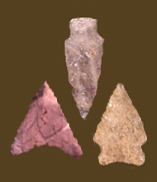
|
LECROY
Chronology The LeCroy point dates to the Early Archaic period, although some archaeologists, following Gardner (1989), place it in the Middle Archaic. Justice (1987) suggests a date range of 8500 to 7800 BP (approximately 7575-6650 BC in calendar years), while Steponaitis (1980) suggests 8600 to 8300 BP (7600-7350 BC). At the West Blennerhassett site in West Virginia, features associated with the LeCroy were radiocarbon dated to between 6710 and 6285 BC (roughly 7700- 7350 BC calendar years) (Johnson et al. 2007). A radiocarbon date of 6300 +/- 100 BC (roughly 7350 BC in calendar years) was obtained from a hearth associated with this point at the St. Albans site in West Virginia (Broyles 1971), and Chapman (1975) suggests a similar age for the LeCroy complex at the Rose Island site in Tennessee. McAvoy and McAvoy (1997) recorded a radiocarbon date of 8300+/-110 BP (roughly 7350 BC) at the Slade site in Virginia. They place LeCroy at the very end of the Early Archaic and the beginning of the Middle Archaic. In the Northeast, some radiocarbon dates suggest that bifurcate base points were used as recently as 7000 BP, a date much younger than in the Southeast (Funk 1993; Kent 1996). Description Blade: The blade is triangular and often appears to have been re-sharpened, resulting in a stubby appearance. Edges are most commonly straight, although they may be occasionally excurvate or incurvate, and are often serrated. Shoulders on exhausted specimens are often flared, the result of being protected by the haft when the exposed portions of the blade were reduced by re-sharpening. Haft Element: The base is deeply notched and bifurcated. The tangs are more pointed than rounded. The stem, which is straight in most examples, is finely chipped along the edges, with no evidence of grinding. Shoulders are straight and at right angles to the stem. In a few examples, the shoulder is absent. Size: Length generally ranges from 15 to 35 mm, although examples up to 50 mm long occur. Width ranges from 15 to 28 mm. Thickness ranges from 3 to 6 mm. Technique of manufacture: Made by soft percussion from small oval bifaces, or pressure flaked from large flakes. Material: In a sample of 53 LeCroy points from the lower Patuxent drainage, Steponaitis (1980) reported that 45% were quartz, followed by rhyolite (42%), chert (4%), and quartzite (3%). In the area surrounding Zekiah Swamp on the lower Potomac, Wanser (1982) found that 66% of 107 LeCroy points were quartz, with 20% rhyolite, 11% chert, 2% jasper, 1% quartzite, and 2% other materials. Cresthull (1972b) described 111 LeCroys from the Chance site on the Eastern Shore, with 79% chert/jasper, 12% quartz, 5% rhyolite, and 4% chalcedony. In the Monocacy River drainage, 92% of 36 LeCroys were rhyolite and 8% quartz (Kavanagh 1982). Quartz LeCroy points predominate in the middle Potomac River Valley, but other local materials are also used (Hranicky 2002). In the Hagerstown Valley, approximately half of Lecroy points were rhyolite (particularly in the eastern areas closest to rhyolite quarries), followed by lesser amounts of quartzite, quartz, and jasper (Stewart 1980). In Western Maryland, LeCroy points are commonly made from local and non-local cherts, but rhyolite is also utilized (Wall 1991). In Delaware, bifurcate base points are commonly made from chert, jasper, and rhyolite (Custer 1996a). Discussion Defined in Literature The LeCroy point was originally identified by Lewis and Kneberg (1955) in Tennessee. This type is described by Broyles (1971) using examples recovered from the St. Albans site in West Virginia. References |
![]()
Search by Shape:
(See Projectile Point Typology) |

|
Thank you for visiting our website. If you have any
questions, comments, Copyright © 2002 by |

|

 Defining Attributes
Defining Attributes